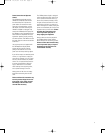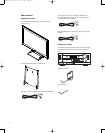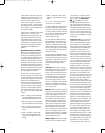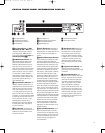
13
TERMINOLOGY
Home theater equipment has changed a
great deal since the first VCR was intro-
duced about 30 years ago. Some of the
terms used to describe and configure
your CVPD50 PDP plasma display monitor
and the internal DVD/CD changer in your
CVR700 may be unfamiliar
. Some of
these terms are described in this section.
Since they share some of the characteris-
tics and technology of CD players, many
of the terms and operational concepts
used in a DVD player are similar to what
you may be familiar with from CD players
and changers, or older video disc formats
such as Laser Disc. However, if this is
your first DVD product, some of the terms
used to describe the features of a DVD
player may be unfamiliar. The following
explanations should solve some of the
mysteries of DVD, and help you to enjoy
all the power and flexibility of the DVD
format and the CVR700.
With the arrival of DVD, disc data capaci-
ty has increased dramatically. On a DVD
Video disc, most of this capacity is taken
up by MPEG 2 video and the multichannel
movie soundtrack in Dolby Digital and/or
DTS. This information is compressed. But
with DVD Audio, most of this capacity is
available for music only, without any
compression. This allows us to put the
audio information on the disc in the same
quality as the original mastering in the
studio, in PCM up to 24-bit/192kHz.
DVD-Audio’s 24-bit system provides sub-
stantially improved resolution of fine
detail, because it describes a specific
point in the musical information using
a 24-digit-long string of ones and zeros
with 16,777,216 possible combinations,
while CD’s primitive 16-bit system offers
only 65,536 options. The 192kHz frequency
allows us to have fast changes in music
made audible, which results in more
dynamism, and also allows us to obtain a
higher bandwidth, up to 96kHz. Although
that is far beyond the human audible
spectrum, it still improves the musical
realism.
Aspect Ratio: This is a description of
the width of a video image in relation to
its height. A conventional video screen is
four units wide for every three units of
height, making it almost square. Newer
wide-aspect-ratio video displays are 16
units wide for every nine units of height,
making them more like the screen in a
movie theater. The program material on a
DVD may be recorded in either format.
NOTES:
■ Due to the advent of HD (high-defini-
tion) programming and the new 16:9
(also called 1.85 or widescreen) aspect
ratio, many newer sources now offer
their own scaling (resizing of the pic-
ture to fit a frame) options which are
accessed through their remote or
through their on-screen menu. T
o take
advantage of CVR700’s robust scaling
capabilities, it is best to allow the
CVR700 to handle all rescaling duties.
This means that all high-definition
external sources connected to CVR700
should be configured to supply a 16:9
picture to CVR700 if at all possible
and all non-HD legacy sources should
supply their native 4:3 (otherwise
called 1.33 or FULL SCREEN) aspect
ratio (with older devices, there are
usually no adjustments or options for
picture size, anyway). Regarding HD
sources, some experimentation may
be necessary, as not all offer a basic
16:9 aspect ratio option without other
parameter settings. The correct mode
may be called 16:9 FULL SCREEN in
some brand products; in other brand
products, you may need to select the
16:9 aspect ratio separately from
selecting FULL SCREEN scaling. Some
experimentation with the settings on
your source device may be necessary
to find the most pleasing appearance.
■ There are two film formats commonly
used in movie theaters today that are
close to the 16:9 aspect ratio of your
CVPD50 screen – 1.85:1 and 2.35:1.
The aspect ratio of your screen is
1.78:1, which is very close to the
1.85:1 film ratio that is found in many
movies recorded on DVDs or broadcast
on television, and these programs will
fill your screen. However, some
movies are filmed in the wider 2.35:1
ratio. Check the jacket of your DVD to
find its aspect ratio. When playing
such a DVD on your JBL Cinema Vision
system, if you have turned off the DVD
Auto Resize feature, or if your analog
video signal is of higher resolution
than 480i or DVI, you may need to
repeatedly press the
Letterbox
Button
z on your remote con-
trol to select either the “2.35 LTRBOX
TO 16:9” or “2.35 LB TO 16:9
CROPPED” mode, choosing the mode
that provides the picture most pleas-
ing to you. Note that the cropped
mode may leave out portions of the
frame in order to fit the image to the
screen, and you may prefer the scaled
mode, even though black bars will
appear on the top and bottom of your
screen.
If you have turned off the DVD Auto
Resize feature, you may also choose how
to view 4:3 ratio images. Y
ou may view
the image as is, in which case black bars
will appear on the left and right sides of
the screen. You may set the system to
stretch the image to fill the screen, using
either linear (the stretch is even across
the entire image) or non-linear (the
stretch is more pronounced towards the
edges of the image, leaving the center
nearly unmodified) scaling. When the
4:3 ratio image consists of a letterboxed
movie, you may simply zoom in to remove
the black bars at the top and bottom of
the screen.
Chapter: DVD programs are divided into
chapters and titles. Chapters are the sub-
sections programmed into a single title
on a disc. Chapters may be compared to
the individual tracks on an audio CD.
Press the
Menu Button
j
to see
a listing of the chapters on a disc. On
DVD-Audio discs, a Chapter is referred
to as a T
rack.
Component V
ideo:
This form of video
signal eliminates many of the artifacts of
traditional composite video signals by
splitting the signal into a separate lumi
-
nance channel (the Y signal channel) and
two color-difference signals (the Pr and
Pb signal channels). With a component
video connection, you will see greater
picture resolution and eliminate many
picture imperfections such as the moiré
patterns often seen on check-patterned
cloth. However, in order to benefit from
component video you must have a video
display with Y/Pr/Pb component video
inputs. Do not connect the component
video outputs of the CVR700 to the stan
-
dard composite or S-video inputs of a
TV or recorder
.
NOTE: The CVR700 is optimized to be
used with the CVPD50 High-Definition
33
34
35
36
37
38
39
40
41
42
43
44
45
46
47
48
49
50
51
52
53
54
55
56
57
38
39
40
4
1
3
1
3
2
3
0
28
29
2
5
26
2
7
28
2
9
3
0
24
2
3
22
21
20
31
37
3
6
35
3
4
3
3
32
3
1
37
36
3
5
34
33
3
2
48
49
50
5
1
47
46
4
5
44
43
4
2
1 2 3 4 5
6
7
8 9 1
0
1
1
1
2
13 14 15 16 17 18
19 20 21 22 23 24
25 26 27 28 29 30
31 32 33 34 35 36
37 38 39 40 41 42
43 44 45 46 47 48
3
3
34
35
36
37
38
39
40
41
42
43
44
45
46
47
48
49
50
51
52
53
54
55
56
57
38
39
40
41
31
32
30
28
29
2
5
26
27
28
29
3
0
2
4
2
3
22
2
1
2
0
31
37
36
35
34
3
3
32
31
3
7
36
3
5
34
33
3
2
48
49
50
51
4
7
46
4
5
44
43
4
2
1 2 3 4 5
6
7
8 9 10 11 12
1
3
1
4
1
5
1
6
1
7
1
8
19 20 21 22 23 24
25 26 27 28 29 30
31 32 33 34 35 36
3
7
3
8
3
9
4
0
4
1
4
2
4
3
4
4
4
5
4
6
4
7
4
8
CVR700 OM 12/17/04 4:23 PM Page 13


















